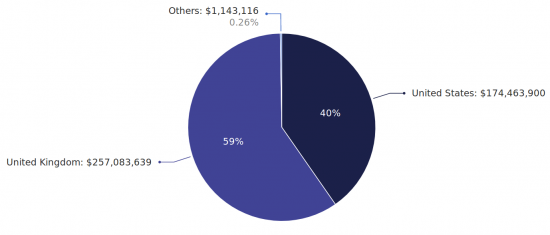Lucian Freud by Lucian Freud
[08/11/2019]When asked if he thought he was a good model for his own work, Freud replied “No, I don’t accept the information that I get when I look at myself, that’s where the trouble starts.” Lucian FREUD (1922-2011) – one of the world’s greatest Post-War portrait painters – changed the way we look at anatomy… starting with close-ups of his own body. He made paintings where flesh occupies the entire canvas – in all its diversity, naked or dressed, old, obese, young, queer, muscular or sick, – he painted the faces of friends and celebrities, including that of Queen Elizabeth II for her Jubilee portrait in 2001, a portrait that sparked virulent controversy.
Grandson of the father of psychoanalysis, Sigmund Freud, Lucian was born in Berlin into a Jewish family. When Hitler came to power, the Freuds fled to England. Lucian was given British citizenship just before war was declared against Germany. He painted his family and friends first before broadening his field to other subjects. His most famous muse was Sue Tilley, who he painted for four years in the early 1990s. In 2015, ‘the market’ elected this body with abundant flesh as the artist’s most representative and most highly sought-after subject, awarding a record price of $56.1 million for his Benefits Supervisor Resting (1994, 150.5 x 161.2 cm) at Christie’s in New York, a record that has not been beaten since.

Lucian Freud’s Turnover – Geographic distribution (2000-2019). copyright artprice.com
Eight years after the National Portrait Gallery organised an exhibition of his portraits and nudes, the Royal Academy of Arts in London has chosen to focus on his self-portraits. Fifty works, all media combined and spanning the artist’s 70-year career, are showing until 26 January 2020 in the small Sackler Wing before honoring the walls of the Boston Museum of Fine Arts as of 1 March 2020. The works allow a fascinating insight into the evolution of the artist’s state of mind: as his body changed, his style matured, and the dramatic vision he offers of himself is revised.
The exhibition also offers a unique opportunity to see self-portraits that have become particularly rare on the secondary market, such as Man with a Feather, Self-portrait (1943) his first ever self-portrait. Lucian Freud was 21 at the time. He represents himself frontally and the painting already bears the special psychological tension that earned him the enthusiasm of collectors. In 2005 at Sotheby’s in London, this early self-portrait fetched more than $6 million against a high estimate of $5.4 million. The current owner has agreed to lend the masterpiece to the Royal Academy on condition of anonymity. A little further into the exhibition, the eye is drawn by Flyda and Arvid, a 1947 drawing that remained in the shadows for 70 years before being offered for sale at Sotheby’s London in 2015. An intense double-portrait – the only one depicting Kitty Garman, Freud’s first wife – the work fetched $1 million.
Lucian Freud painted his body and his life without concessions, in a stark and unflattering light. He preferred the word “naked” to “nude” (which overly ‘artistic’ connotations). When it came to his own reflection, he imposed the same harsh ‘raw-light’ vision, in what he himself described as a “purely autobiographical” exercise.
His personal experiences also found a narrative echo on his canvases, as in Self-Portrait With A Black Eye, (c.1978) , apparently painted after a fight with a taxi driver. Aged 60 at the time, Freud reportedly rushed home to capture the effects on canvas of a bump and a black eye on his flesh. This unusual self-portrait, acquired directly from the artist and then auctioned in 2010 at Sotheby’s London, reached $4.4 million in a format less than 20 centimeters high (18.8 x 14.3 cm).
Lucian Freud described himself as a “sort of biologist” passionate about “internal and hidden things”… a vision he shared with his friend and rival Francis BACON (1909-1992), who also practiced intense introspection via the practice of self-portraiture. The all-time auction record for a work by Francis Bacon – currently showing in a splendid exhibition at Paris’s Centre Pompidou – was generated by a monumental yellow-gold triptych representing Three Studies of Lucian Freud in 1969. The work fetched $142 million at Christie’s NY in 2013. In Francis Bacon’s inimitable distorted and deformed style, Lucian Freud seems to come alive, twisting and turning, forever searching for a meaning to the passing of time.




 0
0
